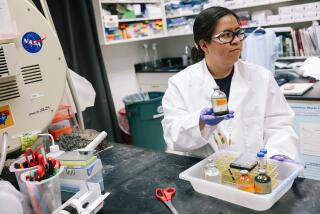Brought Down to Earth : Budget Cuts Eclipse Future of Space Research Facility
- Share via
SAN JUAN CAPISTRANO — As about 65 fifth-graders sat in rapt silence, straining on the edge of their seats to get a better look, Bruce H. Betts mixed a concoction of dry ice, water and brown sugar with a handful of dirt and a few squirts of Windex.
A few minutes later, Betts, a planetary scientist from the San Juan Capistrano Research Institute, held the frozen mixture up for all to see: What looked like a dirty snowball with little jets of gas spitting forth from its surface was actually a comet in the making.
“Here it is, our kitchen comet,” proclaimed Betts as his young audience oohed and aahed with wonder.
Demonstrations like this may come few and far between at the institute, the nonprofit foundation which brings the mysteries of space to about 3,000 visiting students a year.
And so, too, the institution’s serious role in future national scientific research may be curtailed.
Faced with major budget cuts at the National Aeronautics and Space Administration and the National Science Foundation, which have funded the institute for nearly eight years, scientists here are grappling with the reality of having to cut programs and find less expensive housing.
“The fact is, we’re facing some hard financial times,” said Douglas B. Nash, the 63-year-old planetary geologist who founded the institute in 1988 with the help of private donations and temporary grants from the city of San Juan Capistrano. “The funds that we anticipated won’t be coming in. We’re in pretty good shape for next year, but beyond that it doesn’t look good.”
Bracing for an expected 25% cut in its $900,000 federal grants next fiscal year, which starts in September, Nash stressed that the most pressing problem for the institute is housing.
Since 1989, the institute has operated out of an office building at Birtcher Plaza on Camino Capistrano. But with the rent going up, and the institute’s budget going down, the institute could soon find itself homeless.
“Our budget won’t allow us to stay in this building,” Nash said, adding that he is negotiating with owners of the office building to work out a plan for a rent reduction. “We’ve been sweating it out and worrying about it for the past several months. But the bottom line is not favorable to us. Right now, we have no alternative but to move out and look for less expensive quarters.”
And that, Nash said, could eventually affect all of the institute’s programs, which rely on space for conferences and scientific workshops.
For in addition to educational programs for school children, the institute is also noted for the part it plays in planetary research.
During many of its yearly conferences, the institute attracts leading names in planetary science from high-powered institutions like the Massachusetts Institute of Technology, NASA, and Caltech--which in turn eventually benefits the community by filling up hotels and local stores.
But like so many other programs that focus on the planetary sciences--not the more highly prioritized manned space missions--the federal grants just aren’t coming in anymore.
*
“Like virtually every organization that’s funded by NASA, there’s a lot of downsizing going on,” Nash said. “So support for the planetary sciences is unfortunately diminishing. The situation is looking grimmer and grimmer.”
To compensate for the decrease in federal grants, the institute is scrambling to find other sources of funding, including private corporations, foundations and eventually the community. With an operating budget of about $900,000, half of which goes to support research programs at its smaller Tucson, Ariz., branch, Nash already has had to trim staff by a couple of positions to keep costs down.
*
At the Tucson branch, scientists study the origins of the solar system while the facility in San Juan Capistrano focuses on planets and the composition of planet surfaces.
“It would be a tragedy if programs were cut,” said Dodie Puckett, a fifth-grade teacher at Laguna Road School in Fullerton, who shuttled the group of children in for a morning of planetary science and earthbound demonstrations on Tuesday. “There are very few places like this--only a handful--that provide a real valuable learning experience for the kids.”
Jody Black, another fifth-grade teacher from Laguna Road School, agreed.
“What I value most is that the kids are getting up-to-date, current information,” Black said. “With the limited budgets in schools today, this is something kids don’t have a chance to experience.”
For their fifth-grade students, the prospect of returning to the institute was uppermost in their minds. When asked if they would like to come back to learn more about the planets, they all unequivocally responded, “Yes!”
“What’s significant is not only do we give students an introduction to planetary science, we break down some of their fears about science,” Betts said. “They leave thinking that this is actually something that they can do.”






